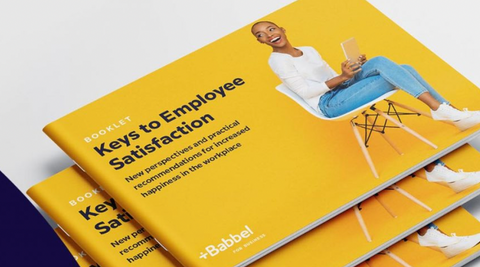This is your ultimate guide to employer branding. Keep reading to learn what employer branding is, why it’s so important, and the various factors which shape it. We’ll also show you how to measure the health of your employer brand — and share 5 steps towards a successful employer branding strategy.
If you search for employee reviews of your company online, do you like what you find? Do you feel confident that your employees would recommend you as an employer? Do talented candidates jump at the chance to work for you?
If yes, it sounds like you’ve built a positive brand reputation. If not, your employer brand could require some TLC.
In the same way that branding helps to attract and retain loyal customers, employer branding helps to attract and retain employees. You might leave your employer brand to chance — or you could devise an effective employer branding strategy, position your company as a great place to work, and give yourself a competitive edge in the hiring market.
Want to take employer branding into your own hands? Excellent! You’ll find everything you need to know in this guide, including:
- What is employer branding?
- Why do you need a strong employer brand? The benefits at a glance
- What factors influence your employer brand?
- How do you know if your employer brand is good or bad? 6 telltale signs
- How to build a better employer brand: 5 steps towards an effective employer branding strategy
- Employer branding: the takeaway

How can you achieve employee satisfaction?
Discover specific ways to increase employee happiness in our free booklet “The Keys to Employee Satisfaction.” Download it now!
What is employer branding?
Your employer brand is your reputation as an employer. It relates to how existing employees and potential candidates perceive you:
- Is your company a good place to work?
- What do people know about your culture and values, and
- what kind of employee experience can they expect if they work for you?
- What image are you putting out to jobseekers?
Employer branding is the ongoing process of cultivating and projecting that reputation. Usually driven by an employer branding strategy, it covers all the intentional measures you take to market yourself as a desirable place to work — and how you uphold that reputation with employees already working at your company.
Note that even if you don’t have an intentional employer branding strategy, you still have an employer brand. Regardless of whether you take conscious steps to build your reputation as an employer, jobseekers and employees will develop their own perception of you.
Employer branding is your opportunity to positively shape the narrative around your company. This will help you to attract and retain top talent — and reap all the rewards of an engaged and satisfied workforce.
On that note, let’s consider the benefits of good employer branding in the next section.

Why do you need a strong employer brand? The benefits at a glance
If you can cultivate a strong employer brand, you’ll enjoy a competitive edge in the hiring market. This, in turn, will have a positive impact on productivity and performance — and on your bottom line.
Here’s why employer branding is so important:
- A strong employer brand will help you attract top talent: A Glassdoor study found that 95% of -jobseekers consider an employer’s reputation when deciding whether to apply for jobs. At the same time, existing employees are more likely to recommend your company if they have a positive experience themselves. As the war for talent continues, anything you can do to increase your desirability as an employer is a bonus.
- Employer branding contributes to a positive employee experience: Employee experience (EX) encompasses the end-to-end experience an employee has with a company, and it has a huge impact on engagement and retention — so much so that employee experience is a top strategic priority for almost 50% of HR leaders. Employer branding and employee experience go hand-in-hand: Invest in improving your employer brand and you’ll automatically improve the employee experience.
- Employer branding is crucial for employee retention: A positive employer brand will not only make it easier to attract top talent — it also helps to boost retention. According to a LinkedIn report, building a strong employer brand can reduce employee turnover by 28%.
- Employer branding has financial benefits: All of the aforementioned benefits will positively impact your bottom line. A good employer brand can reduce the cost per hire by 50%, while boosting retention can help protect you from the cost of employee turnover. Some reports estimate that the average cost of losing an employee equates to double that employee’s salary. So, holding on to top talent is a major money saver.
The importance of employer branding is undeniable. But how exactly is your employer brand determined? What are the different elements that shape it? Let’s take a look in the next section.
Find out in another article, what the positive effects of employee satisfaction are on your business.
What factors influence your employer brand?
There are many different factors which shape your employer brand. These are all the elements that add up to determine how desirable your workplace is. Some of the most important employer branding factors include:
- What corporate benefits you offer and how closely these align with employee expectations (you can learn about the most and least desirable employee benefits here)
- Salaries
- Employee work-life balance
- Professional development and opportunities for career growth
- Company mission and values
- Your commitment to diversity and inclusion
- The quality of the working environment (physical or virtual), including access to the right tools
- Psychological safety, transparency, and trust
- Job security
- Your investment in employee mental health and well-being
Those are the ingredients that make up your employer brand. Next, let’s consider how you can gauge whether your employer branding is hitting the mark.

How do you know if your employer brand is good or bad? 6 telltale signs
There’s no single definitive way to measure an employer brand. However, there are certain indicators that are very telling. Here’s how to evaluate the overall health of your employer brand:
- Look at your job offer acceptance rate
- Measure your employer net promoter score (eNPS)
- Track employee retention
- Run employee satisfaction surveys
- Conduct exit interviews
- Read employee reviews
Let’s expand on those now.
1. Look at your job offer acceptance rate
Of all the candidates you offer jobs to, how many of them accept? Is it typically difficult for you to get people through the door after they’ve been through your hiring process? If a high proportion of candidates are turning you down, you may not be coming off as a good place to work.
2. Measure your employer net promoter score
Employer net promoter score (or eNPS) is measured by asking employees just two questions:
- On a scale of 0-10, how likely is it that they would recommend you as an employer? and
- Why did they give you that score?
Your eNPS gives you insight into employee satisfaction. If your score is low, you can assume that your employer reputation is on the negative side.
3. Track employee retention
People are more likely to stay with employers who offer them a positive experience and generally provide a pleasant place to work. High turnover is a glaring sign that something’s amiss. If your retention rates are low, you’ll want to investigate where you’re going wrong.
4. Run employee satisfaction surveys
Anonymous surveys enable you to gather honest feedback and get a read on how your employees perceive you as an employer. It’s worth designing your surveys with both open-ended questions and quantitative ratings so you can gather a mix of feedback.
5. Conduct exit interviews
Whenever an employee leaves your company, take the time to find out why. Exit interviews (or exit surveys) are a great opportunity to understand why people choose to leave — and to identify areas for improvement. If you’re continually losing people to companies offering higher salaries, for example, you may get yourself a reputation for being an undesirable employer.
6. Read employee reviews
With websites like Glassdoor, employees past and present can leave public reviews of their employers and award them a star rating. These reviews are an invaluable measure of your employer reputation — and because they’re usually anonymous, you can bet that they’re honest. Mind these reviews to see how people talk about you and what you can do better.
Employer branding is just one way to ensure your business is set to thrive. For more success strategies, check out this guide on how to grow and future-proof your business (even in a recession).
How to build a better employer brand: 5 steps towards an effective employer branding strategy
The key to a strong employer brand is an intentional employer branding strategy. Here are 5 steps you can take to build and optimize your employer brand:
- Define your employee value proposition (EVP)
- Master the art of storytelling
- Leverage multiple channels to market your employer brand
- Gather and act on employee feedback
- Practice what you preach
Are you ready to win at employer branding? Let’s consider how to put those steps into practice.
1. Define your employee value proposition (EVP)
Your employee value proposition (EVP) is, quite simply, what employees get out of working for you. It’s what sets you apart from other companies and makes yours an attractive place to work — and it’s crucial for attracting and retaining top talent.
Your EVP is defined by factors such as salary, benefits, work-life balance, and job security. It should also reflect your core values, your mission, and the overall company culture. Ultimately, your EVP captures what it’s like to work for you.
Employer branding example: Airbnb
If you visit the Airbnb careers page, for example, you’re greeted with the headline “Live and work from anywhere.” This embodies Airbnb’s EVP of flexible, location-independent work and their mission to “create a world where anyone can belong anywhere.”
Employer branding example: Apple
The Apple careers page begins with the simple statement “Join us. Be You.” Further down, they expand with “This is where individual imaginations gather together, committing to the values that lead to great work. Here, you’ll do more than join something—you’ll add something.” Apple’s EVP empowers individual ideas and contributions, promising candidates the opportunity to be creative and make an impact.
With a clearly-defined EVP, you can make a powerful case for why people should want to join your organization. Without one, it will be hard to articulate and communicate your value as an employer.
2. Master the art of storytelling
Storytelling is an extremely powerful tool for bringing your employer brand to life and showing people what it’s like to work for you. If done well, storytelling lends authenticity to your employer brand — and it places people front and center.
To make storytelling work for you, there’s one golden rule to follow: Tell real stories based on real people at your organization. And where possible, have these people tell their stories themselves.
Consider the difference between these two approaches:
- Featuring one or two paragraphs on your company ‘About’ page written by the CEO, telling the reader that ‘employees love working here because they have the opportunity to learn and grow everyday’
- Featuring a video (or videos) of employees sharing their own experiences of working at your company.
The second approach is much more powerful, spotlighting different employees’ perspectives and telling your brand story in their own words.
You can learn more about how to master the art of employer brand storytelling here.
3. Leverage multiple channels to market your employer brand
Getting your employer brand out into the world is a marketing endeavor. As such, treat it like any other marketing campaign and make sure you’re leveraging a range of different channels.
First, identify which channels and platforms you want to focus on. Social media platforms such as LinkedIn, Twitter, and Instagram are all great places to start, as are your own company website and your LinkedIn company page. You can also convey your employer brand in job ads, throughout the hiring process, and internally — for example, at company events and as part of internal presentations.
Next, adapt your messaging and media to suit each channel. Which formats will work best for each platform? Are you speaking to potential job applicants or to existing employees?
Any opportunity you have to communicate who you are as an employer — and why that’s desirable — is an opportunity to market your employer brand. Employ a multichannel strategy and craft your message accordingly for each.
4. Gather and act on employee feedback
Who has better insight into your employer brand than those who have lived it first-hand? Nobody! Your employees past and present are in the best position to provide feedback and help you improve your employee branding strategy.
There are many different ways to gather feedback on your employer brand — from anonymous surveys and exit interviews to regular, informal check-ins. This is another area where you’ll want to employ a multichannel strategy: You’re more likely to garner honest feedback if you enable people to deliver it however and wherever they feel most comfortable doing so.
And, most importantly, make sure you act on the feedback you gather. Employee feedback may bring up some challenging issues which can’t be fixed overnight. But, if you ignore them, they’ll only grow bigger — and do more damage to your employer reputation.
5. Practice what you preach
The ultimate key to a strong employer brand is authenticity. You can’t promote a brand image that isn’t actually true — people will soon see through the facade and your brand reputation will suffer.
Don’t promise competitive salaries in your job ads if, in reality, your salaries are below market average. Don’t purport to be dedicated to diversity, equity, and inclusion if you’re not actually taking any proactive DEI measures. Essentially, don’t make any claims that you can’t back up with evidence.
If you want to create a positive employer brand, you need to start by creating a positive employee experience. Make sure your actions match your values — and that the employee experience you deliver is true to the one you promise.
Check out this article with 10 tips for promoting employee satisfaction in your business.
Employer branding: the takeaway
Your employer brand captures who you are as an employer. It conveys why people should (or shouldn’t) work at your company, and it can make or break your ability to attract and retain top talent.
A successful employer branding strategy should be authentic — based not only on your company values, but also on the lived experience of your employees. If you can master employer branding, you’ll set yourself apart as a desirable place to work. That’s a huge leap towards success in today’s competitive hiring landscape!

How can you achieve employee satisfaction?
Discover specific ways to increase employee happiness in our free booklet “The Keys to Employee Satisfaction.” Download it now!





